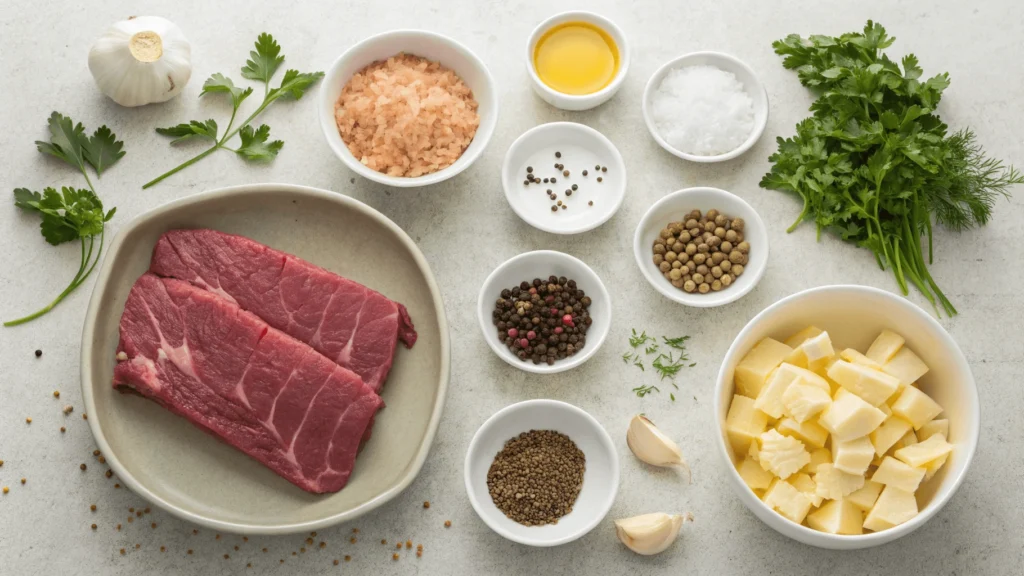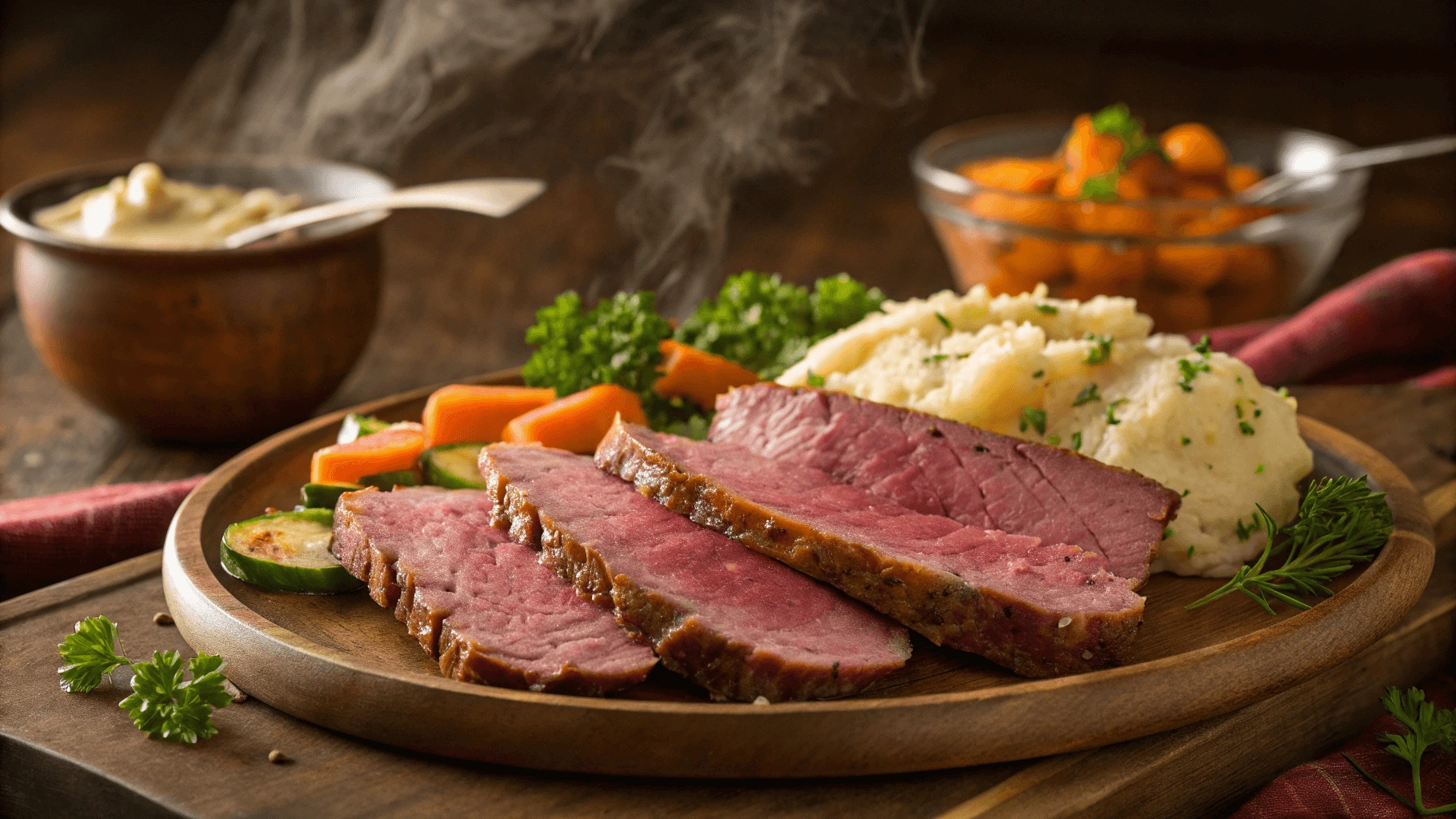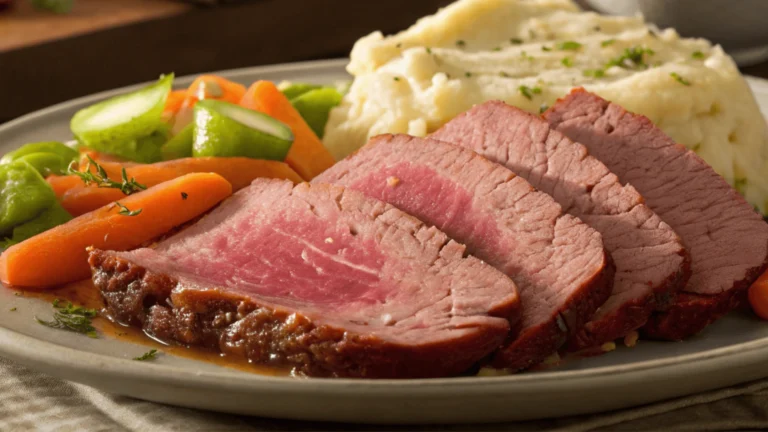Table of Contents
Introduction
Looking for a savory, satisfying dish that’s both hearty and full of tradition? Corned beef might be just what your dinner table needs. Known for its rich flavor, tender texture, and long history, corned beef has become a beloved comfort food in many homes. Whether it’s served with cabbage on St. Patrick’s Day or layered into a classic Reuben sandwich, this beefy favorite never disappoints.
In this guide, we’ll walk you through everything you need to know about corned beef—from what it is and how it’s made to the best ways to cook, serve, and enjoy it. So, whether you’re new to this classic dish or just looking for a foolproof recipe, you’re in the right place!
What Is Corned Beef?
Corned beef is a salt-cured cut of beef, typically made from brisket, that has been seasoned with large rock salt—also known as “corns” of salt—alongside a flavorful blend of spices. Despite the name, corned beef has nothing to do with corn the vegetable; the “corn” refers to the coarse salt used during the curing process.
The meat is known for its tender, juicy texture and deep, savory flavor that develops during the slow cooking process. Traditionally associated with Irish-American cuisine, especially during St. Patrick’s Day celebrations, corned beef is now enjoyed around the world in everything from sandwiches to hearty stews.
It’s often sold pre-packaged with a spice packet, making it convenient for home cooks to prepare. Whether you boil it, bake it, or slow-cook it, corned beef is a versatile option that delivers big flavor with minimal effort.
Key Benefits of Corned Beef
Corned beef isn’t just delicious—it also offers some notable nutritional and culinary benefits:
| Benefit | Description |
|---|---|
| High in Protein | Packed with muscle-building protein to keep you feeling full and energized. |
| Rich in Iron | A great source of iron, which helps prevent fatigue and supports red blood cells. |
| Vitamin B12 Boost | Supports brain health and energy production, especially important in red meats. |
| Long Shelf Life | The curing process extends shelf life, making it a great pantry staple. |
| Versatile Cooking Options | Perfect for boiling, baking, slow-cooking, or slicing into sandwiches. |
| Comfort Food Favorite | Its rich flavor and texture make it a go-to in hearty, satisfying meals. |
| Culturally Iconic | A staple in Irish-American and Jewish cuisine, especially popular on holidays. |

Ingredients Table
| Ingredient | Quantity | Notes |
|---|---|---|
| Corned beef brisket | 3–4 pounds | Includes spice packet if provided |
| Water | Enough to cover brisket | For boiling/simmering |
| Garlic cloves | 3–4 cloves | Peeled and smashed |
| Bay leaves | 2 | Adds subtle depth |
| Whole peppercorns | 1 tablespoon | Optional if no spice packet |
| Mustard seeds | 1 teaspoon | Optional flavor enhancer |
| Carrots | 4 medium | Peeled and cut into chunks |
| Potatoes | 5 medium | Halved or quartered depending on size |
| Cabbage | 1 small head | Cut into wedges, added at the end |
Cooking Instructions
- Rinse the Brisket
Remove the corned beef from its packaging and rinse it under cold water to eliminate excess brine and salt. This helps reduce overall saltiness. - Place in Pot
Place the brisket in a large pot or Dutch oven. Add the spice packet (if included) or your own mix of whole peppercorns, bay leaves, mustard seeds, and garlic. - Add Water
Pour in enough cold water to fully submerge the beef. Typically, about 8–10 cups. - Simmer Gently
Bring the pot to a boil over medium-high heat. Once boiling, reduce heat to low, cover, and simmer gently for 2.5 to 3 hours, or until the beef is fork-tender. - Add Vegetables
Add carrots and potatoes during the last 45 minutes of cooking. Add cabbage wedges in the final 15–20 minutes so they remain crisp yet tender. - Rest the Meat
Once cooked, remove the corned beef and let it rest for 10–15 minutes before slicing. Always slice against the grain for maximum tenderness. - Serve and Enjoy
Plate the sliced beef with the cooked vegetables. Serve with mustard or horseradish if desired.
Pro Tips for Perfect Corned Beef
- Low and Slow is Key:
Always simmer corned beef slowly over low heat. Rushing the process can make the meat tough instead of tender. - Slice Against the Grain:
To ensure every bite is tender, always slice the beef against the grain. This shortens the muscle fibers and makes chewing easier. - Rest Before Slicing:
Let the corned beef rest for at least 10 minutes before cutting. It helps retain juices and boosts flavor. - Don’t Skip the Rinse:
Rinsing helps remove excess salt from the packaging brine—don’t worry, it won’t wash away flavor! - Use a Dutch Oven or Slow Cooker:
Both methods help maintain consistent heat and moisture, making the beef extra juicy and flavorful.
Simple Variations to Try
- Oven-Baked Corned Beef:
Place brisket in a foil-lined baking dish, cover with foil, and bake at 300°F (150°C) for 3 hours. Finish uncovered for 10–15 minutes to get a crispy edge. - Slow Cooker Version:
Add beef, spices, and enough water to cover. Cook on LOW for 8–9 hours or HIGH for 5–6 hours. Add vegetables in the final 2 hours. - Cabbage Swap:
Not a fan of boiled cabbage? Try roasting it separately with a bit of olive oil, salt, and pepper for a caramelized finish. - Spice It Up:
Add a splash of apple cider vinegar or a spoonful of Dijon mustard to the broth for an extra tangy depth of flavor. - Leftover Remix:
Use leftover corned beef in sandwiches, hash, or even as a topping for baked potatoes.
Serving Suggestions for Corned Beef
Corned beef is wonderfully versatile and pairs beautifully with a variety of sides and flavors. Whether you’re enjoying a holiday feast or a cozy weeknight dinner, here are some delicious ways to serve it:
Classic Comfort
- With Boiled Potatoes and Cabbage:
The traditional combo never fails. Boiled red potatoes, tender cabbage wedges, and a little mustard on the side make a hearty, nostalgic plate. - Carrots & Parsnips:
Add earthy sweetness by serving corned beef with fork-tender carrots and parsnips. They soak up the beefy flavor beautifully.
Leftover Magic
- Corned Beef Sandwich:
Layer thin slices of leftover beef on rye bread with Swiss cheese and sauerkraut. Toast it for a warm, melty Reuben-style treat. - Corned Beef Hash:
Dice leftovers and fry with potatoes, onions, and bell peppers. Top with a sunny-side-up egg for a perfect breakfast-for-dinner moment.
Lighter Options
- With a Crisp Green Salad:
Serve warm or cold slices of corned beef on top of a salad with arugula, cherry tomatoes, and a tangy vinaigrette for a fresher take. - With Steamed Veggies:
Lighten things up with steamed broccoli, green beans, or Brussels sprouts tossed with lemon zest and olive oil.
Creative Twists
- Stuffed into Baked Potatoes:
Load baked potatoes with chopped corned beef, sour cream, and shredded cheese for a comforting twist. - Corned Beef Tacos:
Shred the beef and serve it in soft tortillas with pickled cabbage and spicy mustard or horseradish sauce for a fusion bite.

Conclusion
Corned beef isn’t just a holiday favorite—it’s a flavorful, hearty dish that fits beautifully into everyday meals. Whether you slow-cook it for hours or use up the leftovers in creative ways, corned beef offers a satisfying balance of taste, texture, and tradition. From classic pairings to fresh twists, it’s easy to see why this savory dish remains a beloved staple in kitchens around the world.
Ready to try your own delicious version? With the right ingredients, simple techniques, and a bit of love, your next corned beef dish might just become a new favorite at the table.
Frequently Asked Questions
1. What exactly is corned beef?
Corned beef is a salt-cured brisket of beef. The term “corned” comes from the large grains of rock salt used in the curing process.
2. Is corned beef already cooked when you buy it?
That depends. Some canned or deli-style corned beef is pre-cooked, but most fresh corned beef sold in stores needs to be cooked thoroughly.
3. What’s the best way to cook corned beef?
Slow-cooking in a crockpot or simmering on the stove are popular methods. These help tenderize the meat and infuse it with flavor.
4. Can I freeze cooked corned beef?
Yes! Let it cool completely, then store it in an airtight container or freezer bag for up to 2–3 months.
5. What should I serve with corned beef?
Traditional sides include cabbage, potatoes, and carrots. It’s also fantastic in sandwiches, hash, or even tacos.
6. Is corned beef healthy?
Corned beef is high in protein and iron, but also sodium-rich due to the curing process. Enjoy it in moderation as part of a balanced diet.
7. Can I make corned beef without a slow cooker?
Absolutely. You can simmer it on the stovetop or bake it in the oven with flavorful broth and spices.

